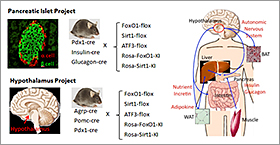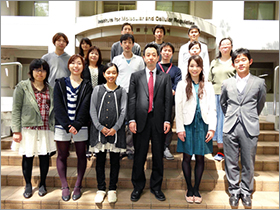
Reserch
Institute for Molecular and Cellular Regulation
Metabolic Signal Research Center

Tadahiro Kitamura professor
At present, there are 9 million diabetes patients in Japan. More strikingly, the number of diabetes patients increased by 38 fold in recent 50 years. Why diabetes is increasing so fast? The most important reason is that we still don’t know how diabetes develops and therefore we cannot prevent the increase in diabetes. It is considered that type 2 diabetes (T2DM) is caused by insulin resistance (loss of insulin function) and pancreatic beta cell failure (loss of insulin secretion). However, recent genetic studies using molecular biology and gene manipulating technology revealed that pancreatic alpha cell (secreting glucagon) failure and the dysfunction of central energy metabolism also account for the etiology of T2DM. Therefore, we are conducting research by using animal models of diabetes with focusing on the pancreatic islets and the hypothalamus. We are attempting to clarify the molecular mechanism of T2DM and apply it to the development of new strategy to treat or prevent diabetes. We really welcome students or graduate students who are interested in diabetes and our research.
Research and Education

We are trying to elucidate the molecular mechanism of pancreatic ß cell dysfunction in type 2 diabetes by analyzing pancreas-specific genetically modified mice.
We are also investigating the molecular mechanism of impaired suppression of glucagon secretion (ß cell dysfunction) in type 2 diabetes.
We are aiming to clarify molecular mechanism by which nutrients (glucose, fatty acids or amino acids) and hormones (insulin, leptin, etc) regulate energy homeostasis in the hypothalamus.
We are investigating the molecular mechanism by which hepatic glucose and lipid metabolism are regulated. We believe that these studies will lead to new strategies to treat or prevent metabolic disorders.
There are two groups in our laboratory; one is the Pancreatic Islet Group (*Kobayashi, Kikuchi, Morita, students and technicians) and another is the Hypothalamus Group (*Sasaki, Kohno, Susanti, students and technicians). * indicates the leader of the group.
Metabolic Signal Research Center

Professor: Tadahiro Kitamura
Associate Professor: Tsutomu Sasaki
Assistant Professor: Masaki Kobayashi, Daisuke Kohno
Research Associate: Hiromi Hashimoto
TEL: +81-27-220-8845
FAX: +81-27-220-8849
E-mail: kitamura@gunma-u.ac.jp
URL: http://taisha.imcr.gunma-u.ac.jp/ ![]()
Recent Publications
- *Kitamura T. The role of FOXO1 in b-cell failure and type 2 diabetes mellitus. Nat Rev Endo 9: 615-623. 2013.
- Sasaki T, *Kitamura T. et al. Miglitol prevents diet-induced obesity by stimulating brown adipose tissue and energy expenditure independent of preventing the digestion of carbohydrates. Endocr J ahead of print. 2013.
- Lee Y-S, *Kitamura T. et al. Hypothalamic ATF3 is involved in regulating glucose and energy metabolism. Diabetologia 56: 1383-1393. 2013.
- Kitamura YI, *Kitamura T. et al. Hepatic FoxO1 Integrates Glucose Utilization and Lipid Synthesis Through Regulation of Chrebp O-glycosylation. PLoS ONE 7: e47231. 2012.
- Talchai C, Kitamura T. et al. Generation of functional insulin-producing cells in the gut by Foxo1 ablation. Nat Genet 44: 406-412. 2012.
- Kikuchi O, *Kitamura T. et al. FoxO1 Gain of Function in the Pancreas Causes Glucose Intolerance, Polycystic Pancreas, and Islet Hypervascularization. PLoS ONE 7: e32249. 2012.
- Kobayashi M, *Kitamura T. et al. FoxO1 as a Double-edged Sword in the Pancreas: Analysis of Pancreas and β Cell-specific FoxO1 Knockout Mice. Am J Physiol Endocrinol Metab. 302: E603-613. 2012.
- Kim H-J, *Kitamura T. et al. Over-expression of FoxO1 in the Hypothalamus and Pancreas Causes Obesity and Glucose Intolerance. Endocrinology 153: 659-671. 2012.
